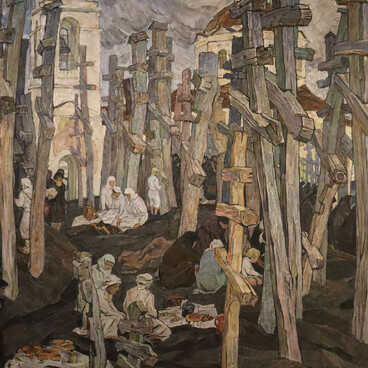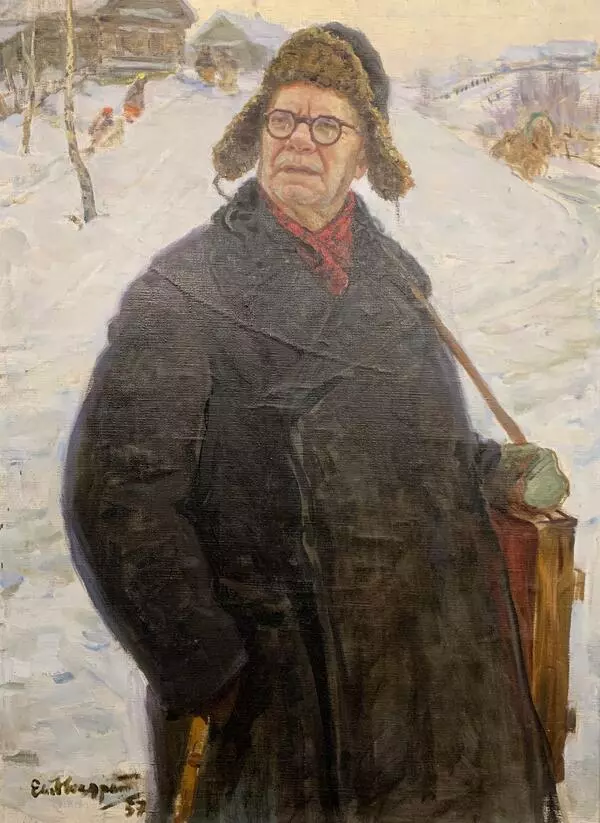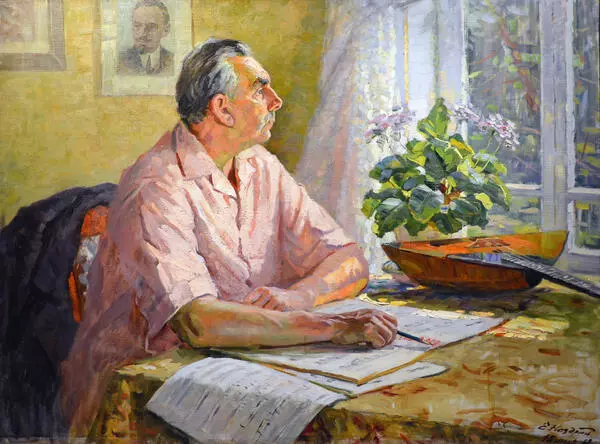The painter and professor Evgeny Alekseevich Nozdrin graduated from the Penza Art and Pedagogical College in 1940. Like many Mordovian artists of that generation, Nozdrin served in the military. During the Great Patriotic War, he was in the Navy and was stationed in the Far East. Even at the front, the artist taught interested comrades to draw, and made sketches every free minute. He brought these portraits sketches of soldiers with him to post-war life. These works are now housed in the Chuvash Republican Art Museum, the Alatyr Art Museum and the State Museum and Exhibition Center ROSIZO in Moscow.
Evgeny Nozdrin’s portraits are a pictorial chronicle of the Mordovian cultural life in the 1950s and 1960s. Delicately and concisely, the artist portrayed an outstanding artist, the first professional singer of Mordovia, Illarion Maksimovich Yaushev, with whom Evgeny Nozdrin was personally acquainted.
Illarion Yaushev graduated from the Moscow Conservatory and the Opera Studio of the State Academic Bolshoi Theater, was a soloist of the Moscow and then the Mordovian Philharmonic. His repertoire included the roles of Ivan Susanin from the opera of the same name by Mikhail Glinka, Mephistopheles from the opera “Faust” by Charles Gounod, and Don Basilio from “The Barber of Seville” by Gioachino Rossini.
Yaushev’s performance was distinguished by the originality of his interpretations and profound and sharp understanding of the characters’ psychology. In addition to opera roles, Yaushev performed folk songs in the Mordovian, Bashkir, Ukrainian, Chuvash and Mari languages. The singer was engaged in collecting and arranging songs, and promoting Mordovian music.
In memoirs of his contemporaries, we read that the singer’s voice sounded free and filled all the entire space around him. The singer turned out to be just as mighty in the artist’s painting — the canvas features only the piano and the figure of the singer. Yaushev leans on the musical instrument with both hands, his gaze is focused, as if the singer awaits the right beat.
The stage costume of the artist includes a black tailcoat, a white vest and a white bow tie. Thanks to the restrained color palette and the neutral background, all the viewer’s attention is focused on the personality of the sitter — an exceptional singer, after whom the State Musical Theater in Saransk is named.
Evgeny Nozdrin’s portraits are a pictorial chronicle of the Mordovian cultural life in the 1950s and 1960s. Delicately and concisely, the artist portrayed an outstanding artist, the first professional singer of Mordovia, Illarion Maksimovich Yaushev, with whom Evgeny Nozdrin was personally acquainted.
Illarion Yaushev graduated from the Moscow Conservatory and the Opera Studio of the State Academic Bolshoi Theater, was a soloist of the Moscow and then the Mordovian Philharmonic. His repertoire included the roles of Ivan Susanin from the opera of the same name by Mikhail Glinka, Mephistopheles from the opera “Faust” by Charles Gounod, and Don Basilio from “The Barber of Seville” by Gioachino Rossini.
Yaushev’s performance was distinguished by the originality of his interpretations and profound and sharp understanding of the characters’ psychology. In addition to opera roles, Yaushev performed folk songs in the Mordovian, Bashkir, Ukrainian, Chuvash and Mari languages. The singer was engaged in collecting and arranging songs, and promoting Mordovian music.
In memoirs of his contemporaries, we read that the singer’s voice sounded free and filled all the entire space around him. The singer turned out to be just as mighty in the artist’s painting — the canvas features only the piano and the figure of the singer. Yaushev leans on the musical instrument with both hands, his gaze is focused, as if the singer awaits the right beat.
The stage costume of the artist includes a black tailcoat, a white vest and a white bow tie. Thanks to the restrained color palette and the neutral background, all the viewer’s attention is focused on the personality of the sitter — an exceptional singer, after whom the State Musical Theater in Saransk is named.





